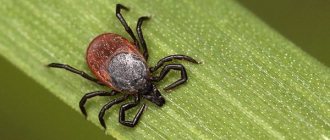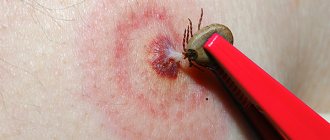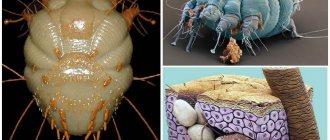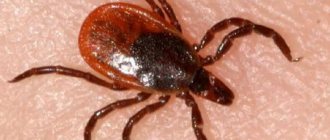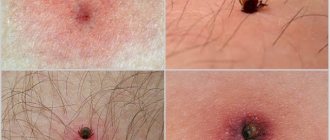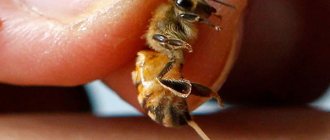Ticks are carriers of numerous infections that lead to serious consequences.
Ticks are insects that pose a danger to human life and health. They are carriers of numerous infections that lead to serious consequences. They cannot always be detected in time. Moreover, even one bite causes infection. When providing first aid for a tick bite, the first step is to carefully remove the insect and also take the patient for examination.
First aid
An attack by a blood-sucking parasite is not only unpleasant, but also very dangerous. After all, ticks are among those parasites that are carriers of dangerous diseases and, when bitten, can transmit an infection to a person. Starting from spring and ending in autumn, bloodsuckers are able to attack humans.
The most frequent visits to medical institutions are associated with suspected infections of encephalitis, borreliosis, as well as inflammatory processes that developed after the attack.
The parasites are most dangerous in regions where there are the greatest number of encephalitis outbreaks. Not every tick is dangerous, only the one that is infected itself, but the risk of infection is quite high. In many ways, it is human actions that can minimize the risk of infection. In cases where a bite has occurred, the further situation, possible complications and the development of the disease depend on the actions.
It is not always possible to notice a parasite attached to the body, and this greatly complicates the situation. The fact is that when these parasites bite, they release an anesthetic enzyme and the person does not feel any discomfort at all. Having drunk blood, it falls off the body on its own and it is only possible to understand that an attack has occurred when symptoms appear.
Another danger is that if a person does not know about the attack and after a while he develops symptoms, he does not associate them with a tick, but thinks that it is a cold or flu. Without proper treatment, the infection develops in the body causing serious consequences.
Therefore, it is very important after every walk in nature, in a park area, to take a shower and carefully examine the body. It takes the parasite a long time to satisfy its hunger, which makes it possible to detect it.
If we talk about symptoms, they include increased body temperature, weakness and drowsiness, aching joints, and a person loses appetite. If a person is hypersensitive, dermatitis develops on the skin. There may also be swelling where there is a dot in the center. It is very easy to spot a parasite that feeds on blood.
First aid for tick bites: common mistakes
Despite its relative simplicity, first aid for tick bites sometimes turns out to be incorrect. This can aggravate the situation and complicate the process of removing the pest. Therefore, it is important not only to know how to properly remove the parasite, but also what not to do.
- Do not smear the insect with sunflower oil or other thick liquids. This will cut off his oxygen and provoke an increased surge of all the harmful substances that are in the body. In this case, infection will occur faster.
- Do not pull out a tick with your bare hands. You don't know what the tick is infected with, so don't touch it with your bare hands. Some bacteria can be transmitted through mucous membranes, microcracks and scratches.
- Don't throw away the parasite. Submit it for analysis to one of the state centers of Hygiene and Epidemiology or to a commercial laboratory and immediately find out for which diseases you need to start treatment.
- Be careful not to crush the parasite during removal. Live ticks are best suited for laboratory analysis. Some places also accept dead insects or their parts, but it is better to clarify this issue in advance with the chosen organization.
- Do not leave the severed head in the wound. Carefully inspect the extracted tick and the bite site; the head of the parasite should not remain there. If this happens, remove it.
If you still have any questions regarding first aid if a person is bitten by ticks, you can ask them by phone at any clinic or hospital, by calling the Rospotrebnadzor hotline or the hygiene and epidemiology centers.
Necessary actions at home
- If we talk about correct behavior, then you will definitely need to go to a medical facility. This will allow you to correctly carry out the removal procedure, check the tick for infection, and receive recommendations on further actions.
- If it is not possible to see a doctor immediately, it is necessary to remove it as soon as possible. The fact is that even an infected parasite does not always transmit the virus to humans. This depends on many factors, but the less it is on the human body, the lower the risk.
- To remove the parasite from the body, patience and calm are needed. For this procedure, tweezers, thread, or special devices that are sold in pharmacies are used. During the procedure, you should not make sudden movements or pull it out of the body, as this will lead to rupture and the head will remain in the wound. Also, you should not squeeze it too much; you can damage the abdomen, which will significantly increase the risk of infection.
- When removing it, it is necessary to grab it in such a way that the head of the tick is held, and not just the abdomen. It is held in the wound by a proboscis, and it is necessary to break this grip. Having captured the blood-sucking animal, you need to make circular movements, as if twisting it and at the same time lightly pull it up.
- Once the tick has been removed, it must be placed in any container that can be closed, for example a jar. You also need to put a piece of damp cloth or cotton wool in the jar to keep it alive.
- In those situations where it was not possible to completely remove it and the head remains in the wound, it must be removed. If this is not done, an inflammatory process will begin, which can cause dangerous complications. You can remove the head with a needle, proceed as in the case of a splinter. It happens that the head is very deep in the wound and it is impossible to get it out; here you cannot do without medical help. It is forbidden to expand the wound on your own.
- The use of oil and other oily liquids is prohibited. When oil is poured on the parasite, it begins to suffocate. Firstly, this will lead to the fact that he will die and it will not be possible to conduct an accurate analysis.
- Secondly, when he begins to choke, he experiences stress and secretes a large amount of fluid from the stomach, where the infection is located. Thirdly, it cannot always be easily reached, because, sensing a threat, it goes deep into the wound.
- The wound is treated, the tick is submitted to the laboratory for research. Remember that symptoms of infection can appear within 1-1.5 months, so during this time period it is very important to monitor your health and consult a doctor if any symptoms appear.
How to remove a tick if it is deep. How to remove a tick from a person?
I was bitten by a tick: action plan
A tick attached to the skin is difficult to ignore. In addition to the fact that its bite causes pain and discomfort, it is very dangerous, because ticks carry dangerous diseases: viral encephalitis, Lyme disease, tularemia and others. In this article we will tell you how to properly remove a tick, what to do with it, how to treat the wound, what consequences to expect and what to do to prevent the bite from happening again.
Signs of a bite, what a sucking tick looks like
Most often we do not feel the moment of a tick bite. It is painless, as the tick secretes an anesthetic substance into the wound. Therefore, usually the only signs of a bite that can be seen are the bloodsucker itself (Fig. 1) or the area where it bit. Sometimes those bitten feel pain and difficulty breathing, and some develop rashes or blisters.
Where to look for a tick?
Ticks stick to places where they are difficult to notice and where the skin is thinner. After a walk in nature during tick season, be sure to inspect yourself, paying special attention to:
- areas covered with hair
- area behind the ears,
- armpits,
- abdominal area,
- inner thighs,
- areas under the knees.
After the tick falls off, the site of its attachment bleeds slightly, gradually turning into a rounded red spot. It increases in size and itches. As it expands, the picture changes. The center of the bite becomes bright red or bluish, and a red spot forms around it due to inflammation.
If a parasite is detected, you need to remove it as quickly as possible and consult a doctor. It is worth going to the clinic if you find a suspicious wound on the skin.
How to get a tick and how to treat the bite site
If a tick has attached itself, it is best to consult a doctor as soon as possible. He will professionally remove the tick and treat the wound. However, a long search for a specialist can increase the likelihood of transmitting various infections from ticks. Therefore, it is often wiser to remove the tick yourself immediately after discovering it.
The first step is to treat the bite site with any antiseptic that you have on hand. Then use tweezers or strong thread to grab the tick as close to the surface of the skin as possible. This is necessary in order to remove the entire tick along with its oral apparatus. The tick must be removed with uniform, moderate force, strictly vertically, without sudden movements or twisting (Fig. 2). After removing the tick, treat the bite mark with an antiseptic again.
Be careful not to damage the tick while removing it from your body. If there are still fragments of it in the wound, do not be alarmed. After some time, the remains of the arthropod will come out of the skin on their own.
If you can't find tweezers, you can try to remove the tick with your fingers, but it is better not to crush the tick with your bare hands. To protect your skin, use a bandage or rubber gloves. You can first wrap the tick in gauze. After the tick is removed, do not forget to wash your hands with soap, or you can wipe your hands with alcohol.
Important! Some people are sure that the tick will crawl out of the wound on its own if you pour vegetable oil or other fat on it. The tick will simply have nothing to breathe. However, doctors do not recommend using this method. Due to blockage of the respiratory tract, the tick may die, having previously released substances into the wound, possibly containing the causative agent of the disease. A lit match is also useless; it will only cause the tick to burrow deeper.
Unfortunately, if you have not been vaccinated, once you have been bitten, it is no longer possible to prevent the disease. As a preventative measure for borreliosis, if the tick has been swollen with blood and there is a suspicion that it has been on the body for at least 24 hours, doctors advise adults and children over 8 years of age to take 4.4 mg/kg, but not more than 200 mg, of doxycycline.
Treatment of the bite after extraction
There are 2 expert opinions on how and with what to treat the bite site. Some say that after removal you should immediately go to the doctor, and some say that you should definitely treat the wound and see a doctor again.
If a visit to the doctor is not expected in the next few hours, then the wound must be treated with a product that would help disinfect the wound and prevent the spread of the virus. The bite site can be treated with peroxide, brilliant green, iodine, medical alcohol, and can also be smeared with chlorhexidine.
If you don’t have specialized products at hand, you can use alcohol. Next, cover the wound with an adhesive plaster, and after examining the doctor, he will give recommendations on subsequent actions. You should not use folk remedies, as this can aggravate the situation and cause unwanted complications.
How does an insect get on a person?
Sometimes a person does not even notice that he has been bitten by a tick, and the problem cannot be detected immediately, since the small dot is almost invisible.
Walking through the park, a person may suspect absolutely nothing, but ticks are already waiting for him. When the insect notices movement, it prepares to attach itself to the victim. Ticks cannot jump, so there is no need to be afraid that it will jump from a distant bush onto clothing.
After a tick lands on human skin, it does not immediately begin to drink blood. First, he will need to find the most suitable place for this. A tick can spend about 3 hours searching for it. It is important to remember that they have favorite places, which include the armpits, areas behind the ears, under the knees and other areas where the skin is especially thin. These areas need to be inspected first and especially carefully. If the tick itself is not visible, but a black bump is found, this may indicate that it has crawled under the skin. Despite the fact that the tick is very small, it easily bites through human skin and then penetrates into the resulting hole.
Use of tablets
Medical institutions give a vaccination that stops the development of the virus in the body. This vaccination is an injection of immunoglobulin, but now a more modern alternative to injections has appeared. Tablets based on iodantiprine. These drugs allow the body to develop immunity against encephalitis and this takes from 12 to 24 hours.
It is recommended to take tablets throughout the entire period of being outdoors, especially in areas with a high risk of infection. Admission is allowed to children from 12 years of age. But, like all drugs, these tablets have contraindications and can cause side effects. Regardless of whether you took the pill or not, if you are attacked by a tick, you must consult a doctor.
Tick attack
These bloodsucking creatures go through several stages of development and are dangerous to humans: adult individuals and individuals in the nymphal stage of development. In the larval stage of development, individuals resemble an adult tick, but are smaller in size and do not attack people.
It should be understood that the procedure for saturating the parasite is not quick. When a blood-sucking substance gets on a person’s clothing, it very slowly rises up to find access to the body. When he finds it, he doesn't immediately latch onto it. It looks for a place with the thinnest skin, then gnaws through it and attaches itself to a blood vessel.
Satisfying hunger can last up to a week, and all this time he uses one wound, firmly sucking on it. That is why it is very important to carry out clothing inspections in nature, and it is important to inspect the body at home.
When saturated, individuals increase significantly in size. Females are large in size, and when saturated they increase to 4mm. Males do not need such a volume of nutrition; they become full very quickly, which is why it is more difficult to detect them on the body. When they are full, the proboscis is carefully removed and the individuals simply fall off on their own.
There is no way to wait for this to happen. As we have already said, the longer the contact with an infected individual, the higher the risk of infection.
If the tick was not found
What if the tick was not detected in a timely manner and remained in the human body? The situation is very dangerous in its consequences. Doctors say that during the first 24 hours after a bite from an infected parasite, infection usually does not occur. The human body becomes infected on the second or third day. This is why it is important to eliminate the insect as early as possible.
The following recommendations will help you avoid further unpleasant consequences:
- Body inspection . After a walk in the forest, the whole body must be examined. Repeat the procedure the next day. By this time, the bite site, which was not detected on the first day, may become red or swollen.
- Human well-being . If, a few days, and sometimes weeks, after a walk in the forest, your health suddenly deteriorates for no apparent reason, you should immediately consult a doctor. The following symptoms indicate a possible infection:
- hyperthermia (temperature can rise to 39°...40°C);
- redness of the chest, neck, face;
- headache;
- excessive weakness;
- nausea, vomiting;
- muscle pain (bothering the back, neck, limbs, lower back);
- skin rash;
- the appearance of red circles around the bite (typical of borreliosis).
The need to examine the body after a walk in the forest is often ignored by those people who have been vaccinated. Even having noticed a tick bite, they do not attach any importance to it and do not visit the hospital. It should be remembered: vaccination only protects against tick-borne encephalitis. But the risk of contracting other diseases still remains.
To protect yourself from a bite, you need to properly prepare for a trip to the forest. It is advisable to choose clothing that provides maximum protection to all areas of the body. They must tie a scarf on their head or wear a brimless hat. And clothes can be treated with special solutions that repel blood-sucking parasites.
Tests to detect infection
There are several types of diagnostics that help detect a dangerous infection in the human body.
Most often, doctors recommend taking an enzyme-linked immunosorbent assay (ELISA). At the initial stage of infection, it is not effective because it cannot detect the virus, but at the middle stage of development it shows good results. It is used to detect encephalitis and borreliosis.
In order to immediately detect infection, a polymerase assay (PCR) is used. This is the fastest possible analysis that can be carried out immediately after the bite. Western blotting is also used, in this case a detection method is used, as in the ELISA analysis, but differs in that the infection can be diagnosed at an early stage.
Not all clinics conduct these studies; it all depends on the capabilities of the laboratory. Therefore, the doctor gives directions for the necessary tests that can be carried out in these conditions.
Preventive actions
You can hear the opinion that under certain weather conditions, ticks hide and do not attack people. The opinion is erroneous and there is no way to hope that you will be in nature and avoid meeting a bloodsucker.
They pose a danger to humans from spring, as soon as the sun warms up and the temperature rises above zero, until autumn, until the first frosts hit. It should always be remembered that a person can take actions that will protect him and minimize the likelihood of an attack.
You should dress properly for outdoor activities. First of all, it is better to choose light-colored clothing on which insects can easily be spotted. You should wear pants and tuck them into your socks. Shoes should be closed and high. A jacket must be chosen with cuffs that fit tightly to the wrist and neck; it is tucked into pants. Hats are required.
Now it is possible to purchase specialized products that can provide human protection. They are produced in the form of sprays. There are sprays that are applied to the skin, and there are those that are intended for treating clothing.
The latter are more effective, but remember, they cannot be used on clothing on the body. It must be treated before going to nature and can only be worn after the product has completely dried off.
Avoid thickets and dark areas, stick to paths, and have a picnic in open areas. Inspect your clothes as often as possible, take a shower when you arrive home, and examine your body.
If you are relaxing in a country house or country house, you can treat the area with solutions. Specialized preparations are diluted with water and applied to grass and plants using a spray bottle. After application, the products can repel parasites for 1.5 months.
How to protect yourself from a tick bite
The precautions are quite simple. When going outdoors, you need to cover your entire body as much as possible: thick clothing with long sleeves, as well as closed shoes and a hat. In the forest, you need to constantly inspect yourself and your companions, especially your hair, open areas of the body, places under the knees and the bends of the elbows. In the forest and upon returning, you should also inspect the pets that accompanied you on your walk. Ticks can also be brought into the house with bouquets of flowers and other gifts from the forest.
How does a wound heal?
There are no general symptoms or periods for wound healing, since everything depends on the body and each person tolerates bites differently. For some, the wound can heal within 3 days, without disturbing the person at all. And for some, this process may take a month.
If we talk about acceptable standards, in other words, the healing period, which is considered normal, then it is 2 weeks. But during healing, there should be no symptoms such as swelling, severe redness, or suppuration of the wound, since such symptoms indicate that an inflammatory process is developing due to infection. You should consult a doctor as soon as possible to prevent the situation from getting worse.
You cannot use medications to heal and relieve inflammation on your own, since there are several reasons for the appearance of the inflammatory process. You can apply ointment and only cause harm, which will again cause an adverse reaction in the body.
Most often, inflammation appears as a result of a slow regeneration process, when an abscess appears that dries out for a long time. A person can also become infected while scratching a wound. And another reason is when the parasite was not completely removed and the head remained in the wound. Depending on the situation, the specialist prescribes treatment.
